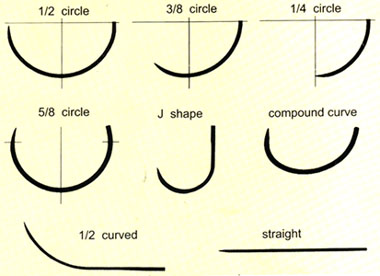Suture size
| 6-0 to 8-0 (smaller) | Vessel repair |
| 5-0 | |
| 4-0 | Subcuticular skin closure |
| 3-0 | Dermal stitches/skin closure |
| 2-0 | |
| 0 (larger) | Fascial closure |
Suture type
| Absorbable | Non-absorbable | |||
| 50% tensile strength | Absorbed | |||
| Natural | Chromic gut | 3-7 days | 1 month | *Silk |
| Synthetic |
Monocryl (6-7) |
3-4 weeks |
Nylon (Ethilon (5-6), Dermalon, *Nurolon) | |
|
*Vicryl (3-4) |
3 weeks |
2-3 months |
Polypropylene (Prolene) | |
|
PDS (6-8) |
6 weeks |
6 months |
Dacron (*Ethibond, *Tevdek, *Ticron) | |
|
Maxon |
3 weeks | 7 months | ||
- * = braided; (#) = # of knots needed
- Monofilament will require more knots (> 5) than a braided suture (3-4) to keep from slipping
- However, braided suture theoretically has more surface area to harbor bacteria/foster infection
- Times given are approximately time to lose 50% of tensile strength
- Non-absorbable = maintains full tensile strength for > 60 days
- Choose short absorbable (Monocryl, chromic) for rapid-healing tissue (mucosa, dermal, etc.)
- Choose longer absorbable (PDS/Maxon) for longer healing (fascia) or poor healing (diabetic, steroids)
- Chromic = catgut treated with chromic acid to make it last longer. Dries out quickly once out of the package. Lasts longer in presence of infection.
- Prolene tends to retain bends/folds and is finicky to handle - try to keep the tail under control as the assistant
- Synthetic suture has less inflammatory reaction than natural (chromic, silk)
Common uses
- Deep dermal = 3-0 Vicryl
- Subcuticular = 4-0 Monocryl
- Interrupted sutures for skin closure with later removal = nylon
- Securing drain to skin = 2-0 silk or 3-0 nylon
- Vessel repair = 6-0 Prolene
- Fascia = 0 looped PDS
Needle types
Needle size
- 1/2 to 5/8, referring to how much of a curve there is (3/8 is most common)
- Straight needles are used in OB-GYN for closing C-section incisions (can sew a lot faster)

Tapered (circular cross-section; non-cutting/less traumatic) - use in most situations
|
TP/CTX (trigger point), 1/2 circle close abdominal fascia |
TP-1 | 65mm |
| CTX | 48mm | |
|
CT (circle taper), 1/2 circle close deep tissue after fascia; CT-2 to close uterus |
CT | 40mm |
| CT-1 | 37mm | |
| CT-2 | 26mm | |
|
SH (small half-circle), 1/2 circle bowel, tissue in breast surgery |
SH | 26mm |
| SH-1 | 22mm | |
| UR (urology), 5/8 circle | UR-6 | 26mm |
|
RB (renal artery bypass) delicate vessel/duct anastomosis; may use with a Castro needle holder (very delicate) |
RB-1 |
17mm |
|
RB-2 |
13mm | |
|
BB, 3/8 circle also used for small vessel anastomosis |
BB |
18mm |
| BB-1 | 22mm |
Cutting (triangular cross-section; for cutting through tough skin, bone, tendon)
|
FS (for skin), 3/8 circle FSLX (extra large) - close skin with a lot of tension |
FSLX | 39mm |
| FSL | 30mm | |
| FS2 | 19mm | |
|
PS (plastic surgery) with micropoint , 3/8 circle PS2 - common skin closure |
PS2 | 19mm |
| PS3 | 16mm |
Staplers
- Staple leg length - needs to be long enough to avoid over-compressing tissue, but short enough to form a tight seal for hemostasis
- GIA = GastroIntestinal Anastomosis
- White = 2.5 mm staple leg length (vascular)
- Blue = 2.8 mm (bowel)
- Green = 4.8 mm (stomach)
- TA = ThoracoAbdominal
- 30, 55, or 90 mm long staple line
- Ethicon stapler
- White = thin (2.5 mm open, 1 mm closed) (vascular)
- Blue = regular (3.6 mm open, 1.5 mm closed)
- Gold = regular/thick (3.8 mm open, 1.8 mm closed)
- Green = thick (4.1 mm open, 2 mm closed)
- Black = very thick (4.2 mm open, 2.3 mm closed)
Thumbroll tutorials
Scrubbing
Suturing and closing skin
- Instrument tie
- Two-handed tie
- One-handed tie
- Simple interrupted
- Horizontal mattress
- Vertical mattress
- Deep dermal
- Subcuticular closure
- Steri-strips
- Dermabond
- Suture removal
- Staple Removal